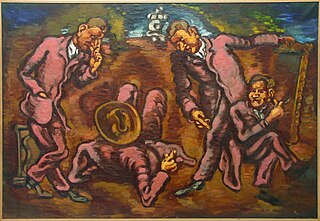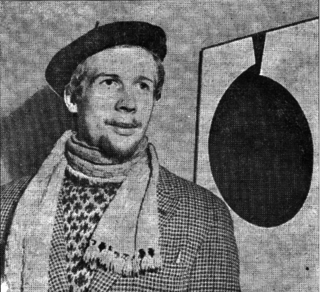Related Research Articles

Johan Thomas Lundbye was a Danish painter and graphic artist, known for his animal and landscape paintings. He was inspired by Niels Laurits Høyen's call to develop nationalistic art through depictions of Denmark's characteristic landscapes; the historical buildings and monuments, and the country's simple, rural people. He became one of his generation's national romantic painters, along with P. C. Skovgaard and Lorenz Frølich, to regularly depict the landscape of Zealand.

Adam August Müller, a Danish history painter, was one of Eckersberg's favourite students. Generally unhealthy and dead at 32, his work is recognized as an important component in Danish art. His favourite subjects were historical and religious themes.
Eva Isabel Koch is a Danish sculptor who has gained fame with her video installations. In 2011, she was awarded the Thorvaldsen Medal.
Elsa Agnete Yvonne Nielsen née Bendixsen was a Danish graphic artist. The grand-daughter of the painter Laurits Tuxen, in 1946 she married the graphic artist Palle Nielsen.

Ingvar Cronhammar was a Swedish-Danish sculptor, who lived in Denmark from 1965 until his death. He gained a unique place in Danish art with his dark monumental works, often presenting an eerie confrontation between modern technology and the primitive past.

Torben Niels Ebbesen is a Danish sculptor and painter. His installations in contrasting materials and other abstract works can be seen in locations in Denmark, Germany and Sweden as well as in several Danish museums.

Arne Haugen Sørensen is a Danish painter and illustrator. Since the 1980s, he has become one of Denmark's most productive religious artists, decorating over 25 churches.
Paul Preben Gadegaard was a Danish painter and sculptor. He developed an Abstract geometrical style in his painting but is best remembered for decorating factories in Herning, contributing significantly to the development of industrial art in Denmark.

Svend Johansen was a Danish painter, scenographer and illustrator.

Ole Albert Christian Schwalbe was a Danish painter. He was one of the painters in the Linien artists association who in 1956 initiated the second generation of Danish Constructivism which they called concrete realism.
Kasper Jacob Heiberg was a Danish painter and sculptor. Though largely forgotten today, in retrospect Heiberg is considered to have made an important contribution to the development of Danish painting.
Mary Jane Crafoord Muus was a Danish painter and illustrator. Most of her works portray people, either in portraits or walking about on streets or market places in foreign countries. She is remembered above all for her sensitive, realistic illustrations in a wide range of Danish books. One of Denmark's foremost 20th-century illustrators, she had a unique style of her own.
John Olsen was a Danish sculptor, illustrator and painter.
Stig Brøgger was a Danish artist who worked with sculpture, painting, installations and photography. His aims have been to show how art contributes to man's experience of life and his understanding of the surrounding world.
Jørgen Boberg was a self-taught Surrealist Danish painter and illustrator.
Holger Jens Sophus Jensen was a Danish painter.
Knud Wedel Hvidberg was a Danish painter and sculptor.

Erik Kristoffer Raadal was a Danish painter. During his short life, Raadal became one of Denmark's most important landscape painters of the 1930s, often painting scenes around Gjern, his home town in central Jutland.
Michael Otto Albert Kvium is a Danish artist. He has excelled in a number of fields such as painting, illustrating, sculpting and various performance genres. Since the early 1980s, he has created grotesque realistic works, depicting the darker side of life.

Carl Christian Ferdinand Wentorf was a Danish painter. His works included genre pieces and portraits. He won the Royal Danish Art Academy's Annual Medal in 1901.
References
- 1 2 3 4 Ann Lumbye Sørensen. "Thomas Bang" (in Danish). Kunstindeks Danmark & Weilbachs Kunstnerleksikon. Retrieved 16 November 2014.
- 1 2 Torben Weirup. "Portræt - Thomas Bang" (in Danish). KunstOnline.dk. Retrieved 16 November 2014.
- 1 2 "Thomas Bang" (in Danish). Kant. Retrieved 16 November 2014.
- ↑ "Thomas Bang". Den Store Danske (in Danish). Retrieved 16 November 2014.